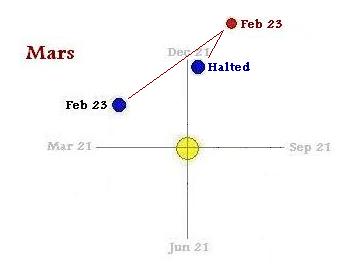
| |
 |
 Spaceweather featured the Mars/Moon conjunction of Feb 25 on its home page, advising viewers that
any star close to the crescent Moon should be considered to be Mars and provided no reports or photos
from this conjunction/eclipse the following day.
Spaceweather featured the Mars/Moon conjunction of Feb 25 on its home page, advising viewers that
any star close to the crescent Moon should be considered to be Mars and provided no reports or photos
from this conjunction/eclipse the following day.
Last August when Mars came historically close to Earth, the red planet was dazzling. Now it's merely one among many bright stars in the evening sky. Tonight, once again, you can find it with ease. Just look for the crescent moon after sunset. Red Mars will be right beside it.
The position of Mars for an Earth in a stalled or reversed orbit would show Mars rising earlier in the day and setting earlier in the evening, thus coming early to the conjunction. Mars in the position to be viewed from an Earth in an orbit proceeding normally would be visible at sundown on Feb 25 and be visible until close to midnight, but would be overhead at sundown for a stalled or reversed orbit. Mars has an orbital period of 686 days, compared to Earth with 365 days. Thus is moves more slowly. The orbit of Mars did not halt or reverse by this conjunction, as Earth did. Thus Mars would be visible earlier in the day, from an Earth in a stalled or reversed orbit, and not line up with the Moon!